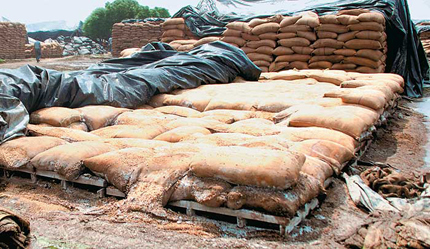
Complex problems do not have straightforward answers. But politicians need to come up with simple answers in order to explain things, especially if they happen to be lawyers.
In order to tackle the high food inflation finance minister Arun Jaitley has asked states to “crack down on hoarders”. The food inflation for the month of May 2014 was at 9.5%(as measured by the wholesale price index and 9.4% (as measured by the consumer price index). Over the last ten years food inflation has averaged at 8.1% and has even gone above 10% in recent times.
Jaitley’s response to tackle food inflation was similar to what P Chidambaram had said in December 2013. “There is also a need to deal wisely with harvesting and marketing and deal strictly with hoarding and profiteering,” the former finance minister had said.
So is India’s food inflation problem only because of hoarding? As mentioned at the beginning, complex problems do not have simple answers. And India’s food inflation is a really complex problem.
One of the biggest hoarders of food is the government of India. The Food Corporation of India (FCI) indicates its grain stock at the beginning of every month. As on June 1, 2014, the food grain stock stood at 74.8 million tonnes. This primarily included rice and wheat.
This stock is much more than what is required by the government to run its various subsidy programmes and also to maintain an emergency stock and strategic reserve requirements. In fact, the Commission for Agricultural Costs and Prices(CACP), a part of the ministry of agriculture, estimated in May 2013, that anywhere between 41-47 million tonnes, would be a comfortable level of buffer stocks.
In fact, the level of the stocks with FCI has gone up dramatically since May 2004, when the Congress led United Progressive Alliance (UPA) first came to power. At the beginning of June 2004, the stock of food grain had stood at 32.3 million tonnes. It has more than doubled since then.
With more and more food grains landing up in the godowns of the government it is not surprising that price of food grains has risen over the last few years. The price of rice has risen by 12.75% over the last one year. The rise in the price of wheat has been rather subdued at 3.64%. But around the same time last year, the price of rice had risen 12.37% over a one year period.
In order to control grain prices, in the short run the government needs to sell some of its hoard in the open market. And that is exactly what it plans to do. It plans to sell 50 lakh tonnes of rice in the open market at a price of Rs 8.3 per kg. More importantly the government needs to stop hoarding rice and wheat, and not buy more than what it requires.
Other than the price of rice, the price of milk, fruits and egg, fish and meat has also risen at rapid rates of 9.57%, 19.4% and 12.47%, respectively. As far as hoarding is concerned India does not have the supply chain infrastructure required to hoard these food products. In this case, the inflation is clearly a case of the demand outstripping supply.
In a recent report titled What a Waste Crisil Insight points out that “inflation in egg, fish and meat has consistently [been] at 10-15% since 2009. The story is similar for milk and milk products where inflation peaked above 15% in 2012.” Hence, inflation in these products is not a recent phenomenon and more than that it has nothing to do with hoarding.
Crisil Insight points out that “loose fiscal policy, rising demand for high-value food items and substantial increase in wages — especially rural wages, as a spillover [of] the rural employment guarantee scheme – have translated into higher demand for proteins. This has raised the prices of items such as milk and milk products, egg, fish and meat as supply falls short of demand. The production of milk and eggs has risen only 3-4% a year, compounded annually, during 2009-10 to 2012-13, while inflation in this category has risen 14-15%.” Hence, the only way to control inflation in this area is to encourage more production of milk, eggs, fish and meat, and that of course, needs a lot of effort and cannot happen overnight.
So that leaves us with vegetables. Vegetable prices on the whole have fallen by 0.97% over the last one year. But this aggregate hides the fact that potato prices have risen by 31.44% in the last one year. In this case, the hoarding argument can apply given that hoarding potato is far more easier than hoarding other vegetables or fruits or meat for that matter.
Interestingly, onion prices haven’t gone up in the last one year. They have fallen by 2.83% during the period. At the same time last year, onion prices had gone up by 94.28% over a period of one year. In order to stop anything along similar lines from happening again, the government has imposed a minimum export price of $300 per tonne for onions. In fact, the ministry of commerce has been asked to come up with a similar measure for potatoes as well.
Hopefully, all these measures should have some impact on the burgeoning food prices. To conclude, it is important to understand that food inflation is not just because of traders hoarding food products. Prices of different food products have risen due to different reasons over the last ten years. And these reasons need to be specifically addressed, if food prices are to be controlled.
The article was originally published on www.firstbiz.com on June 19,2014
(Vivek Kaul is a writer. He tweets @kaul_vivek)

